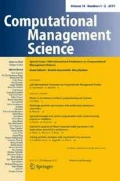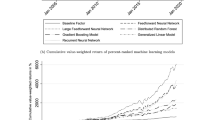Abstract
A simple measure of similarity for the construction of the market graph is proposed. The measure is based on the probability of the coincidence of the signs of the stock returns. This measure is robust, has a simple interpretation, is easy to calculate and can be used as measure of similarity between any number of random variables. For the case of pairwise similarity the connection of this measure with the sign correlation of Fechner is noted. The properties of the proposed measure of pairwise similarity in comparison with the classic Pearson correlation are studied. The simple measure of pairwise similarity is applied (in parallel with the classic correlation) for the study of Russian and Swedish market graphs. The new measure of similarity for more than two random variables is introduced and applied to the additional deeper analysis of Russian and Swedish markets. Some interesting phenomena for the cliques and independent sets of the obtained market graphs are observed.




Similar content being viewed by others
References
Anderson TW (1957) An introduction to multivariate statistical analysis. Wiley, New York
Boginski V, Butenko S, Pardalos PM (2003) On structural properties of the market graph. In: Nagurney A (ed) Innovations in financial and economic networks. Edward Elgar Publishers, Northampton
Boginski V, Butenko S, Pardalos PM (2005) Statistical analysis of financial networks. Comput Stat Data Anal 48:431–443
Boginski V, Butenko S, Pardalos M (2006) ining market data: a network approach. Comput Operat Res 33:3171–3184
Bonanno G, Caldarelli G, Lillo F, Micciche S, Vandewalle N, Mantegna RN (2004) Networks of equities in financial markets. Eur Phys J 38:363–371
Devlin SJ, Gnanadesikan R, Kettenring JR (1975) Robust estimation and outlier detection with correlation coefficient. Biometrika 62:531–545
Garas A, Argyrakis P (2007) Correlation study of the Athens stock exchange. Physica 380:399–410
Huber PJ (1981) Robust statistics. Wiley, New York
Kendall MG, Stuart A (1967) The advanced theory of statistics. Inference and relationship, vol 2. Charles Griffin & Co. Ltd., London
Kim HJ, Lee Y, Kahng B, Kim IM (2002) Scale-free networks in financial correlations. J Phys Soc Jpn 71:1–5
Kim DY, Jeong H (2005) Systematic analysis of group identification in stock markets. Phys Rev 72
Laloux L, Cizeau P, Bouchaud JP, Potters M (1999) Noise dressing of financial correlation matrices. Phys Rev 83:1467–1470
Mantegna RN (1999) Hierarchical structure in financial market. Eur Phys J 11:193–197
Mantegna RN, Stanley HE (2000) An introduction to econophysics: correlations and complexity in finance. Cambridge University Press, Cambridge
Onnela JP, Kaski K, Kertesz KJ (2004) Clustering and information in correlation based financial networks. Eur Phys J 38:353
Plerou V, Gopikrishnan P, Rosenow B, Amaral LAN, Stenley HS (1999) Universal and nonuniversal properties of cross correlations in financial time series. Phys Rev 83:1471–1474
Tumminello M, Aste T, Matteo TD, Mantegna RN (2005) A tool for filtering information in complex systems. Proc Natl Acad Sci 102:10421–10426
Tumminello M, Aste T, Matteo TD, Mantegna RN (2007) Correlation based networks of equity returns sampled at different time horizons. Eur Phys J 55(2):209–217
Tumminello M, Lillo F, Mantegna RN (2010) Correlation, hierarchies and networks in financial markets. J Econ Behav Org 75:40–58
Wilcox RR (2005) Introduction to robust estimation and hypothesis testing. Academic Press, San Diego
Zebende GF (2011) DCCA cross-correlation coefficient: quantifying level of cross-correlation. Physica 390:614–618
Acknowledgments
The authors are partially supported by LATNA Laboratory, NRU HSE, RF government grant, ag. 11.G34.31.0057.
Author information
Authors and Affiliations
Corresponding author
Appendices
Appendix A: Derivation of the formulas for connection between the classical and the sign correlation coefficients for the normal distribution
Suppose that \(X,Y\) are normally distributed random variables and the correlation coefficient between \(X\) and \(Y\) is \(\rho (X,Y)=\rho \).
Consider the random variables \(U,V\) having normal distribution with zero mean and variance equal to one, and such that \(\rho (U,V)=0\). Let the random variable \(X=\alpha U + \beta V\), the random variable \(Y=\gamma U + \delta V\). To ensure that \(\rho (X,Y)=\rho \) it is necessary to satisfy the following conditions:
This equation system allows the following solution: \(\alpha =\beta =\frac{1}{\sqrt{2}}\), \(\gamma =\frac{1}{\sqrt{2}}(\rho +\sqrt{1-\rho ^2})\), \(\delta =\frac{1}{\sqrt{2}}(\rho -\sqrt{1-\rho ^2})\). Thus, random variables \(X = \frac{U}{\sqrt{2}} + \frac{V}{\sqrt{2}}\) and \(Y = \frac{(\rho + \sqrt{1-\rho ^2})U}{\sqrt{2}} + \frac{(\rho - \sqrt{1-\rho ^2})V}{\sqrt{2}}\) have correlation coefficient \(\rho \).
Let \((\rho +\sqrt{1-\rho ^2})>0\), then (17) looks like:
As the random variables \(U,V \sim N(0,1)\) and are independent, then the probability of hitting the sector formed by two lines from \((0,0)\) at angle \(\alpha \), equals to \(\frac{\alpha }{2\pi }\).
Angle between lines \(U=-V\) and \(U=\frac{2\rho \sqrt{1 - \rho ^2}-1}{2\rho ^2 - 1}V\) forming the sector \(\left( U > -V, U > \frac{2\rho \sqrt{1 - \rho ^2}-1}{2\rho ^2 - 1}V\right) \), equals to \(\alpha =\frac{3\pi }{4}-arctg\left( \frac{2\rho \sqrt{1 - \rho ^2}-1}{2\rho ^2 - 1}\right) \).
Consequently,
Thus,
Let \((\rho +\sqrt{1-\rho ^2})<0\), then (17) looks like:
Angle between lines \(U=-V\) and \(U=\frac{2\rho \sqrt{1 - \rho ^2} - 1}{2\rho ^2 - 1}V\) forming the sector \(\left( U > -V, U < \frac{2\rho \sqrt{1 - \rho ^2} - 1}{2\rho ^2 - 1}V\right) \), equals to \(\alpha =\frac{\pi }{4}-arctg\left( \frac{2\rho \sqrt{1 - \rho ^2} - 1}{2\rho ^2 - 1}\right) \).
Consequently,
Thus,
If \((\rho +\sqrt{1-\rho ^2})=0\), or \(\rho =-\frac{\sqrt{2}}{2}\), (17) looks like this:
Thus, the sign correlation coefficient as a function of the classical correlation coefficient is given by:
Appendix B: Contents of maximum cliques and independent sets for Russian and Swedish market graphs
Rights and permissions
About this article
Cite this article
Bautin, G.A., Kalyagin, V.A., Koldanov, A.P. et al. Simple measure of similarity for the market graph construction. Comput Manag Sci 10, 105–124 (2013). https://doi.org/10.1007/s10287-013-0169-3
Received:
Accepted:
Published:
Issue Date:
DOI: https://doi.org/10.1007/s10287-013-0169-3




